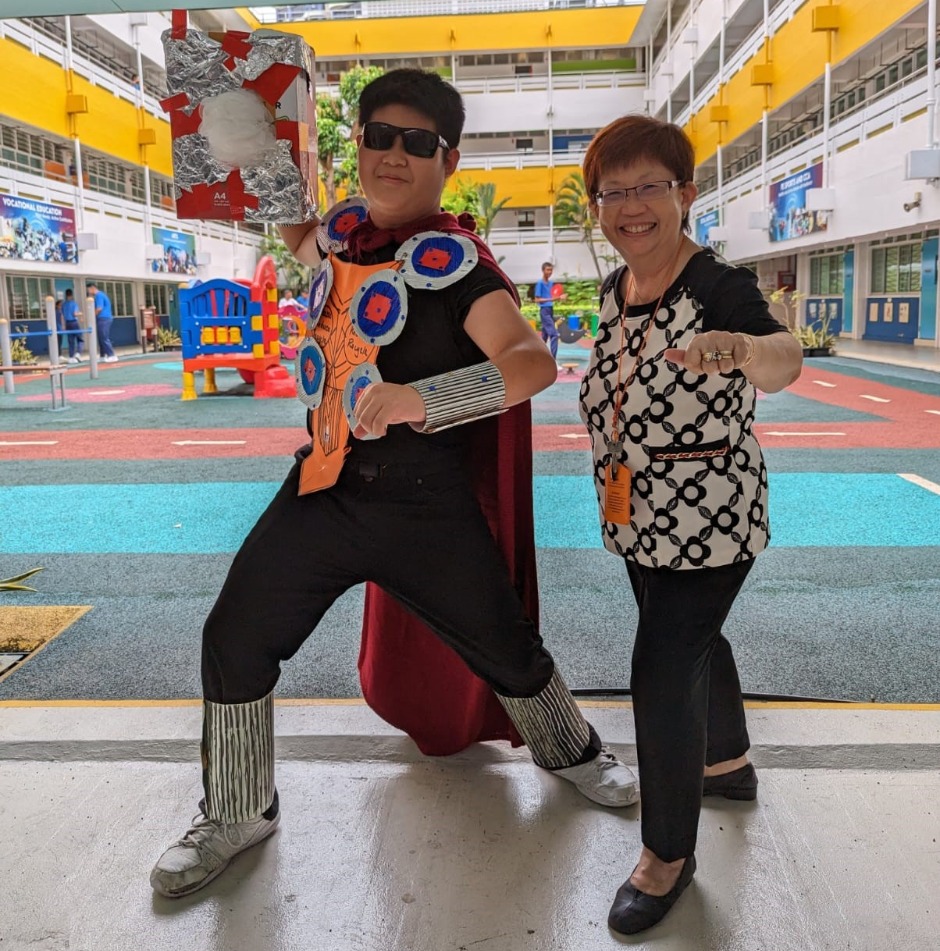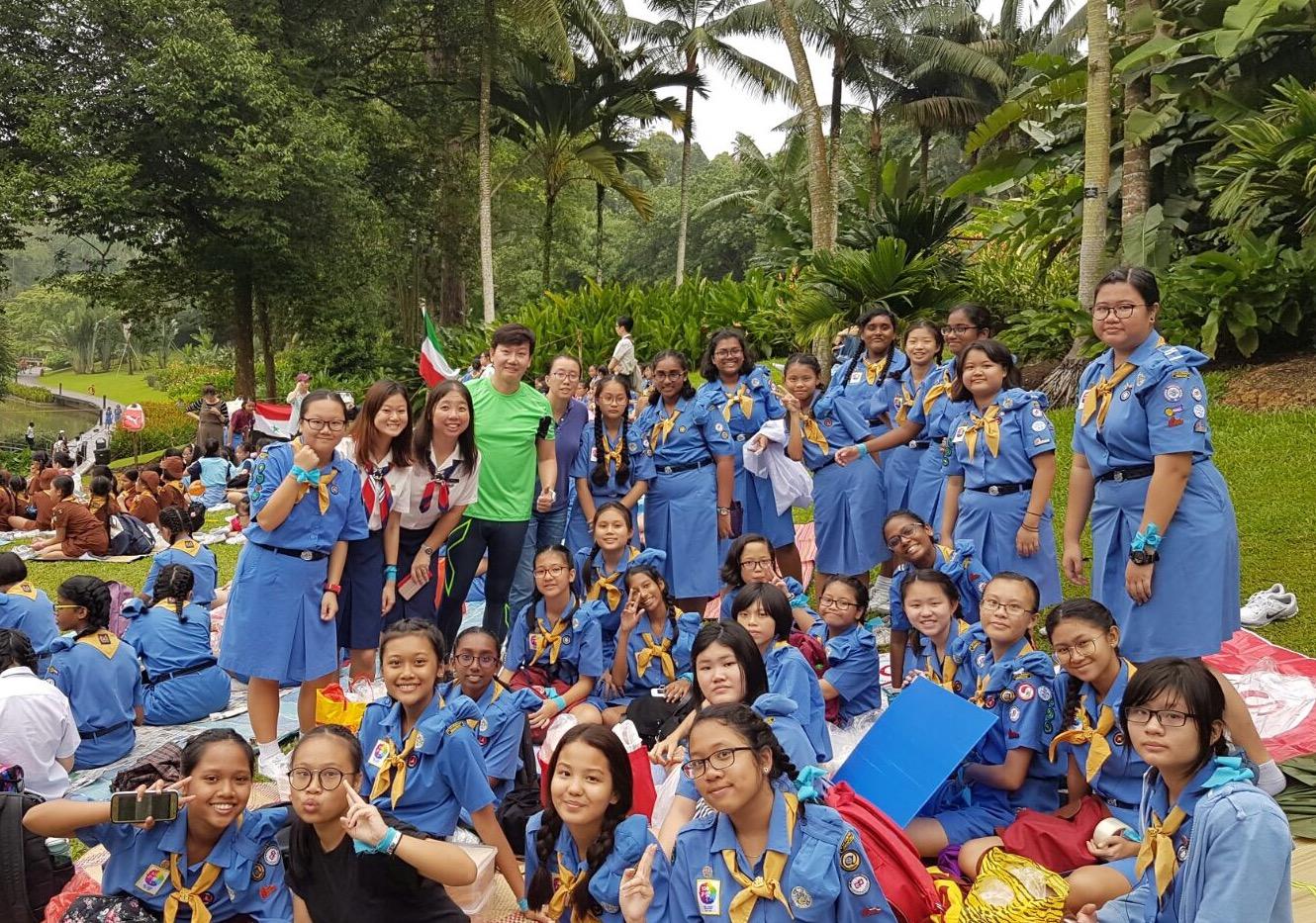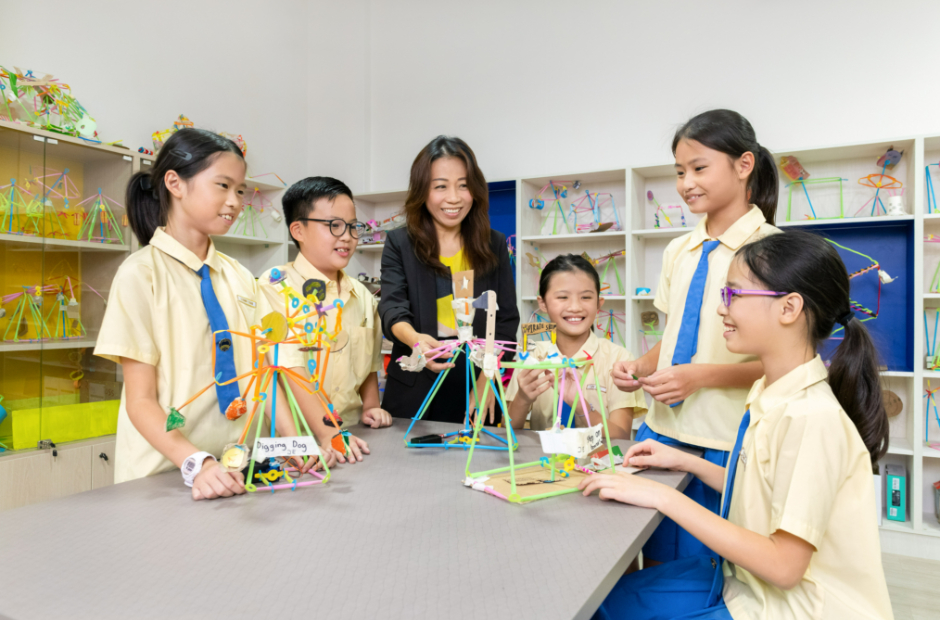Mdm Ng has served as a principal for 18 years, including five years leading a SPED school. Here, she shares innovative teaching methods used to engage students, and how students with special educational needs are driven to strive for success on their own terms.
When I first stepped into Katong School, I had been an educator for over 30 years and taught at mainstream schools.
I was pleased to join Katong School as its principal in 2018, and what I saw on the walls was truly captivating. The artworks were by our students, who are aged between seven to 16 with mild intellectual disabilities. As I interacted with the student artists, I came to appreciate their unique communication style. While their verbal expressions may be limited, they conveyed emotions through their mastery of brushstrokes.
In my first year, which coincided with the Istana’s 150th anniversary, President Halimah Yacob unveiled a set of commemorative cookies, whose packaging featured artworks created by five of our students who drew inspiration from the flora and fauna of the Istana.
This year, one of our students also demonstrated her artistic talent in a significant way, Secondary 2 student Azra Ufairah Binte Hafizur Rahman, likes photography. She captured the enduring beauty of the Tiong Bahru estate in her photograph titled “Window to the Past”. The artwork was displayed at the 18th Ngee Ann Photographic Exhibition. Her snapshot evoked such a sense of nostalgia in me.
Over the years, I learnt that while my students may encounter challenges in grasping concepts, problem-solving, or communication and social interactions, they possess remarkable strength and potential.
 Mdm Ng witnessed how her students conveyed their emotions through artistic expression. Student Azra Ufairah Binte Hafizur Rahman’s photograph of Tiong Bahru estate, titled “Window to the Past”, was on display at the 18th Ngee Ann Photographic Exhibition.
Mdm Ng witnessed how her students conveyed their emotions through artistic expression. Student Azra Ufairah Binte Hafizur Rahman’s photograph of Tiong Bahru estate, titled “Window to the Past”, was on display at the 18th Ngee Ann Photographic Exhibition.
I started my journey as an educator teaching Chemistry at Jurong Junior College before leading New Town Secondary School and Concord Primary School as Vice-Principal, prior to being appointed Principal of Teck Whye Primary School.
During this time, I’ve witnessed how nurturing students’ potential can propel them to remarkable accomplishments.
However, this significance is even more pronounced in SPED schools, where our students demonstrate an uncanny ability to surpass expectations.
My students consistently amaze me with their determination and resilience, defying challenges to chase their own versions of success.

Former Katong School student, Hui Xuan Lin Florence, who won 5th place in the Bowling Women’s Singles Finals during the Special Olympics World Summer Games 2023.
Seeing former students like Florence (pictured above) embody the Special Olympics athlete oath – ‘Let me win. But if I cannot win, let me be brave in the attempt’ – reminds me and my staff about the significance of cherishing our students’ bravery, personal progress, and growing confidence.
I also fondly recall celebrating the accomplishments of our students who courageously competed against adult swimmers at the 2023 National Para Swimming Championships, achieving new personal records through sheer determination.
Lessons in reverse: Students encourage us to reflect on our teaching methods
Guiding our students to learn and discover humbles us, as they play a major role in sharpening our craft to better meet their diverse learning needs.
The school’s Transition Planning Coordinator (TPC) learnt a lot from a student who faced challenges in expressing his needs, such as communicating when he needed rest or was feeling upset. Frequent meltdowns occurred up to three times a day as a result. The TPC felt helpless in calming him and bringing him back to classroom activities.
“Just as we teach our students, our students teach us as well.”
Mdm Ng Puey Koon
The turning point came when she decided to take a step back and observe his actions, emotions, and reactions to his surroundings more intentionally.
Upon discovering his tactile learning style, she designed more sensory and hands-on activities. For example, when teaching him about money, she creatively covers coins with shaving cream, prompting him to retrieve and count them. The soothing touch of the cream not only calms him, it also enhances his engagement and facilitates his learning process.
Like many of my teachers, she emphasises the importance of understanding each child and consistently seeking ways to address their needs and nurture their strengths, rather than focusing on their limitations. It’s a sentiment I wholeheartedly share.
A shared love of food paved the way for this aspiring chef
To nurture our students’ strengths, we have created an environment that enables them to learn at their own pace. This achievement rests on the shoulders of our dedicated staff who have big hearts and exhibit a readiness to innovate.
I still remember the days when my F&B trainer, vocational education instructors, and I relentlessly explored ideas to reach the heart of one student whom we knew had potential waiting to be unlocked.
Initially disinterested in the vocational track, the student gradually connected with his trainer over a shared love for food. Recognising his artistic talent, the trainer remarked, “Once he prepares his food, he will beautifully plate the dish.”
Despite facing setbacks, the student eventually entered the vocational certification track at Delta Senior School, albeit a year later than expected.
He humbly attributes his success to his F&B trainer who introduced him to cooking demonstrations, shared anecdotes from personal restaurant experiences, and guided him in recognising the significance of active contributions within his home, school, and community.
Unlocking our student’s potential is a team effort
During my tenure at MOE’s Pre-School Education Branch and subsequently at the Early Childhood Development Agency in Dec 2012 and April 2013 respectively, I gleaned the significance of collaborating with parents, families, and an extended network of caregivers. This understanding steered me toward fostering a culture of collaboration and shared accountability among teachers, Allied Professionals (APs), and families in my role as a principal at Katong School.
The Occupational Therapists (OT) at Katong School observed that students have shorter attention spans and difficulties keeping spatial distance from others. Together with teachers and APs, we developed a three-prong Sensory Play Experience to address these needs.
Arrangements were made to allow students 15 to 30 minutes of daily engagement with a range of balance, spatial, touch, hearing and visual activities in the OT’s room. Weekly hour-long sessions of structured sensory play were also incorporated in between lessons, along with five to ten-minute sensory breaks to facilitate seamless transitions.
The team was subsequently awarded the MOE-NCSS Innovation Award (Commendation) in 2020 following the successful launch of this pilot project.
I am reminded of how these collective efforts also impacted an eight-year-old when he enrolled into Katong School with speech delay. When he spoke, he found himself repeatedly uttering sounds or words, and getting stuck on certain phrases or sentences. He was also visibly withdrawn.
“With ongoing school and family support, the socially withdrawn child blossomed.”
Mdm Ng Puey Koon
A breakthrough was achieved through regular therapy sessions where he learnt to synchronise each syllable with tapping rhythms to address his stuttering. By applying this technique during social interactions, he gradually regained the confidence that had been chipped away by his stammering.
I noticed the Speech and Language Therapist’s (SLT) deliberate efforts in fostering his language expression and keeping his teachers and parents well-informed on his progress. With the SLT’s encouragement, his parents generalised the strategies used in school with the child at home and in public spaces e.g., allowing ample wait-time for the child to respond, using visual and verbal cues to provide additional support in communicating.
With ongoing school and family support, the socially withdrawn child blossomed in the Circus Arts CCA, performing at school and corporate events, eventually becoming a lead member. I’m grateful to the dedicated teachers, SLTs, and parents who invested their time and effort to bring about meaningful engagements that unleashed his potential.
Prioritising students and their agency
At my first Secondary 4 Parent-Child-Teacher Conference (PCTC), a parent proudly told me, “I have no regrets about sending my son to Katong School, except that I should have done it earlier.” I felt a surge of pride for my team, accompanied by a sense of gratitude for these affirming words.
This PCTC was special because students led and planned the event. They included a segment expressing their appreciation to parents, teachers, and classmates, and showcased a gallery walk sharing their Katong School journey.
The confidence of parents in their children’s capabilities motivated me to continue fostering student agency. I spearheaded the “Our School, Our Voice” platform, empowering students to share their feedback for a more sustainable Singapore. Since its implementation, students have championed recycling by decorating the school toilets with their craftwork. “I’m never going to see recyclables the same way ever again,” I thought to myself.
Leading a SPED school is no easy feat, but my students and staff are my motivation. They give me the strength to persevere, making every stride along this rewarding journey unforgettable.






